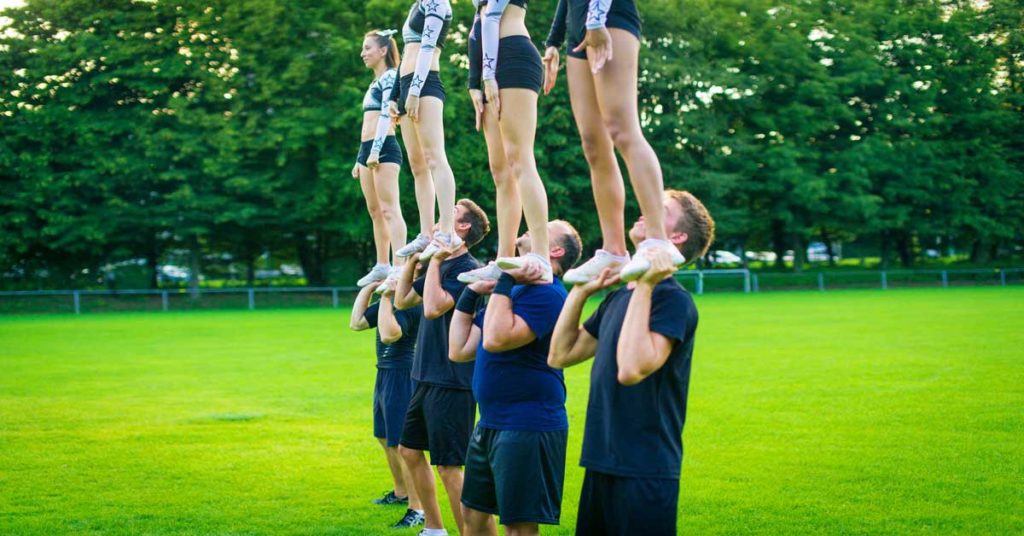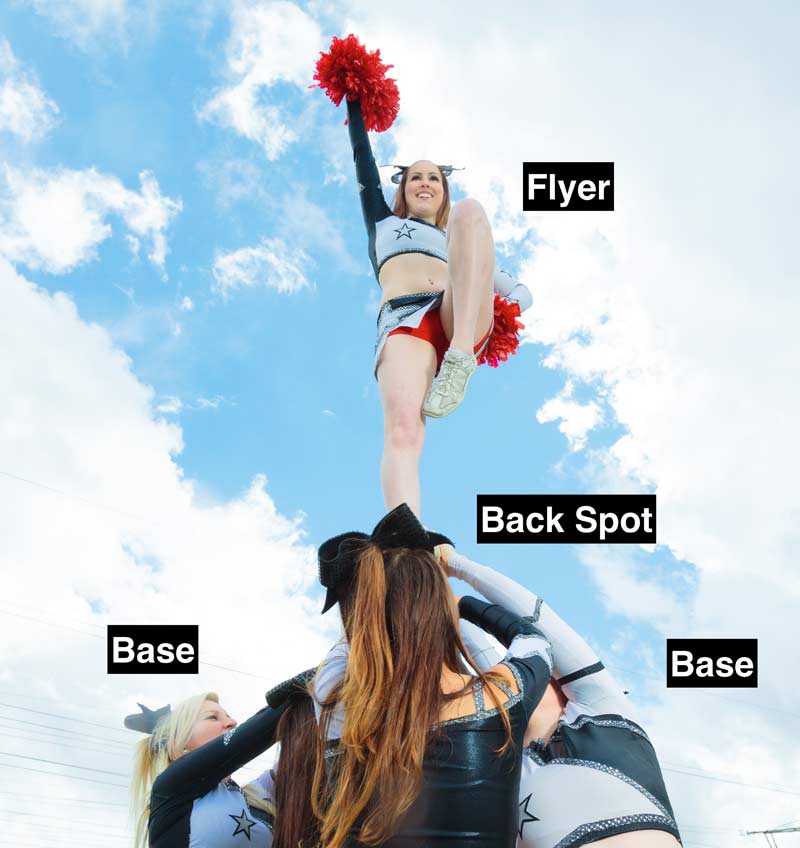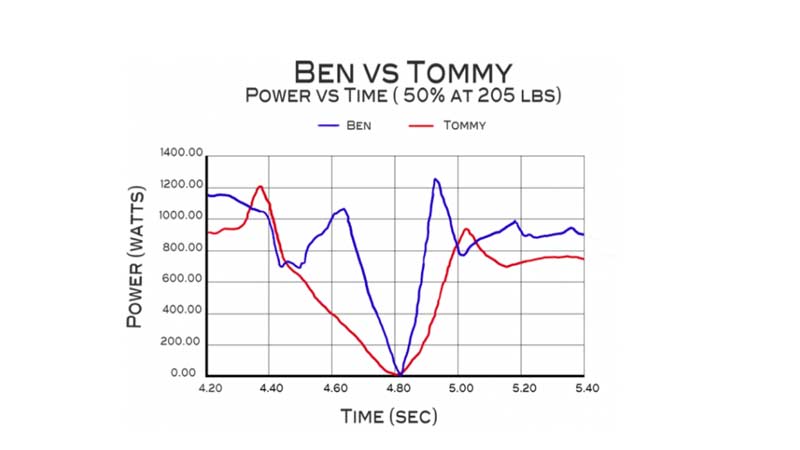
Typically in this field, the interns and graduate assistants are given the opportunity to work with less high-profile sports. During my time as graduate assistant strength and conditioning coach in Miami, I was fortunate enough to work with the coed cheer team. In this article I will dive into the needs analysis, character development, and training protocols utilized, as well as the progressions.
Needs Analysis
Cheerleading is a sport comprised of three different positions: the spotter, the base, and the partner.

Spotter: The spotter’s job is to make sure the partner completes the stunt safely. Spotting puts a huge focus on eccentric strength due to the need to catch the partner as they descend from the stunt. The spotter is normally in charge of the counting process to make sure all parties involved in the stunt execute the stunt at the same time.
Base: The base’s primary responsibility is to act as the foundation for lifts and pyramids, and the athlete who fills this position must be able to perform stable isometric contractions to control the lift. In addition to having strong isometric contractions, the athletes must also assist the spotters in safely dismounting the partner from the stunt, which requires another major emphasis on eccentric strength. Normally in co-ed cheer the male cheerleaders are used in this position.
Partner: The last position is the partner. The partner is the apex of the stunt, and their responsibilities differ from the rest of the positions. They require the ability to extend their hips and arms rapidly while maintaining high amounts of core stability from the extremities being put into the extended positions relative to the stunt at hand. They need to maintain flexibility of the lats, triceps, anterior hip, and hamstrings to sustain longer holds up top. Stability in the hips, ankles, and core is also needed to maintain positions in specific stunts, especially if the stunts require the partner to be on one leg or have one arm more distal from the center of mass.
Common injuries seen in cheerleading are to the lower extremities, upper extremities, trunk, neck, and head. These injuries are normally due to falls from improper execution of the stunts, lifting or tossing with poor technique, twisting a body part through high ranges of motions, or a lack of eccentric strength.
Character Development
Cheer presented me with a variety of challenges as a young coach in the profession. One of the most interesting things I found is that a lot of underclassmen had no experience in physical training or lifting, but they spent a lot of time in competitive cheer or similar sports such as gymnastics. As a coach, the biggest question I had to ask myself was, “How do I get buy-in with a team that has never touched a weight before?”
One of the most interesting things I found in cheer is that a lot of underclassmen had no experience in physical training or lifting, says @KTelegadas. Share on XI started doing some research into the psychology of getting “buy-in,” and the majority of the research that I came across had to do with business development, leadership, and other psychological techniques that coaches have used over the years. Among the podcasts, articles, and books that I read were three distinct common factors:
1. People won’t care about what you want them to do, until they know you care about them.
- Take time to get to know any athlete, client, or person you work with. What are their hobbies? What do they study? What problems are going on currently with them that you can assist with? What kind of music do they like? Etc.
2. Set a standard, then slowly challenge the standard to be raised after success has been achieved.
- An example I gave for our teams was being five minutes early to anything that we did as a team. If they weren’t five minutes early, then they were late. Once the team agrees to a rule similar to this, have them decide what everyone will do if someone is late to make up for it. Once the team decides what the selective course of action will be, hold your ground with the standard.
- To progress this standard, add another standard in the session. An example of this would be once the standard has been met five times in a row to never have this “hot streak” end.
3. Once athletes show leadership qualities, give them a little more responsibility.
- A great example that I used was quizzing the athletes on what we did for the warm-ups on total body days, lower body days, and upper body days. Once I took note of who was really doing well with these “verbal quizzes,” I let them lead the warm-ups as trust was established. Remember, the goal of training is not just to create better athletes, but better leaders and people who can take what they have learned in training and implement it in their respective careers going forward. No one is an athlete forever; eventually you will need to transition, whether you are a retired professional or a high school athlete who did not get an offer to play in college.
Training Protocols
Socrates once said, “No man has the right to be an amateur in the matter of physical training. It is a shame for a man to grow old without seeing the beauty and strength of which his body is capable.” To this day, I view cheer as no different than any other sports team that I had the pleasure of working with. So why treat them any differently?
To this day, I view cheer as no different than any other sports team that I had the pleasure of working with. So why treat them any differently?, asks @KTelegadas. Share on XTherefore, my setup was different than most universities that train men and women’s cheer. I had the men twice a week on Tuesday and Thursday for roughly 12-15 weeks, depending on schedules. One day was in the weight room and the other was outside in the parking lot/field due to conflicts with in-season training with other teams. I was allotted only an hour to work with them, from 5:45 a.m. to 6:45 a.m. each day. For the women, I had Mondays and Wednesdays for 45 minutes from 6:30 a.m. to 7:30 a.m.
Now the tricky part for me was that they were always “in season” during the school year. During football season the team cheered every Saturday at the games, but during basketball the team cheered two to three times per week depending on how many home games we had that week. On top of that, they practiced from 6:00-9:00 p.m. three times a week.
The first thing I made sure to do was set up my macro cycle to reflect the schedule. I blocked off each season in separate blocks. In each block I had to account for the following variables:
1. Would they be coming off cheering at a practice/game the night before?
2. What intensity was practice done at?
- This included speed of movements, planes of motion, and overall fatigue coming out of practice.
- The majority of the motions were in the sagittal and frontal planes.
3. Where is the team currently at as far as mastery of progressions/regressions goes?
- Ex: squat
- Can they squat with body weight?
- Can they squat from a goblet loaded position?
- Can they squat with a bar on their back?
From there, I determined what testing protocols I wanted to use after examination of their movements on the first day I had with them. My example for the men’s team is below:
- 3-5 Rep Max Barbell Squat – Used to predict lower body strength.
- Max Rep Push-Up Test – All of my men coming in could barely perform 15 push-ups without fatiguing out. Some couldn’t even perform one push-up with proper form. (I will do a full breakdown on how we progressed in these later in the article.)
- Max Reps Pull-Up Test – Very similar to the push-up test above and used to increase upper back stability and strength. It also has a high correlation to grip strength, which will help increase overall strength.
Note: Overall, my team had little to no experience in training, so the tests were more strength-based to develop a base of training to prevent injuries down the road. Remember: If you do not have good positioning, you cannot build a pattern. Without a good movement pattern, we can’t build a base for strength/stability. Without strength and stability, power might be hindered.
To assist any younger coaches, I have broken down my progression of push-ups for our team. Most of the men’s cheer team originally struggled with doing three push-ups when I started back up with them in the fall of 2017 with a whole roster of new guys. I began their general physical preparatory phase using eccentric push-ups during a set period to develop the ability to absorb force. Eventually, I wanted to progress to a max repetition push-up test.
I had the men’s cheer team emphasize a max push-up test for two reasons:
- Our setup, as far as time went, was very limited in the weight room. At some schools, cheer is not considered a varsity sport if they do not compete at the NCAA level. My cheer team didn’t compete; therefore, I could only have them in the weight room one day a week due to time conflicts with competitive sports teams. My other day was spent as a circuit day outside with little to no equipment with them, so I had to get creative. The second day is when they did most of the push-ups.
- Due to the limited time in the weight room, I took time to develop the barbell squat/other squat variations with them, with a total body emphasis after the squat variations for the day. I used a lot of pulling/retraction exercises to take stress off all the pushing that would be done on the second day. On the second day I still did more pulling exercises than pushing, due to some of the players having upper cross syndrome.
- Since I only had one day to develop one lift in the weight room, a max push-up test was better than a barbell or dumbbell bench test outside of putting emphasis on the squat. Most of the athletes benefited more than ever before due to the team’s overall low training experience.
Below I have attached the famous “Ben vs Tommy” chart from Triphasic Training by Cal Dietz and Ben Peterson.

This chart shows Ben (blue line) and Tommy (red line). The authors saw that the two subjects could produce the same amount of force (415 1RM bench press); however, they noticed that Ben had a higher power output than Tommy, at 50% of 1RM. Ben could eccentrically (lengthening phase of the muscle) absorb force at a higher velocity than Tommy, thus translating into better power production for his upper body pressing. This chart can be practically applied to my scenario with men’s cheer at the most basic level. Most athletes at the college level have no base to absorb force; therefore, they cannot properly reproduce it in a powerful manner once it comes time to perform their plays, routines, etc.
Most athletes at the college level have no base to absorb force; therefore, they cannot properly reproduce it in a powerful manner once it comes time to perform their plays, routines, etc. Share on XHere are some examples from the base of my training to the more advanced forms of push-up training I did for all my cheer guys.
- Eccentric Push-ups: Lower your body at a set time of 3-5 seconds per repetition; reset your body back up in the push-up position without pressing back up. You just reset your knees back down in a quadruped position and perform the next rep from the top of the normal push-up position. Do this for three sets of 8-10 reps at a 3- to 5-second lowering pace and reap the benefit on how to put your body under tension/absorb force.
- Side note: If the athlete has trouble with range of motion or core stability, utilize this same variation on a bench to diminish the intensity of the push-up.
- Isometric Push-ups: This is the next progression I do with my athletes. Have the athlete get into a proper push-up position and drop to the floor with their chest hovering about 1-2 inches above the floor. Have them hold it for three sets of 30 seconds and progress from there if need be.
- Push-ups: Have the athlete descend into the isometric position with their chest touching the floor and produce force to get the body back up into starting push-up position with the arms fully extended.
- Weighted Push-ups: Add a 10- to 25-pound plate to the back of the athlete and have them repeat the push-up with good form. If their form deviates from what is expected, cut the set.
- Side note: If the athlete is capable of doing push-ups with weight, when going back to the eccentric and isometric stages of force production in the push-up progressions, have them do the same volume but add in that they have to push up out of the eccentric or isometric variation of the push-up.
Target these muscles in accessory work to help improve the quality and volume of push-ups for your athletes.
- Upper Back (lats, lower traps, rhomboids, posterior delts)
- Bench-Supported T’s & Y’s: 3-4 x 10-20 reps
- Bench-Supported DB Rows: 3-4 x 6-12 reps
- Bent-Over Rear Delts: 3-4 x 10-20 reps
- Note: All these exercises benefited our team in the max pull-up test as well, due to these specific movements strengthening the upper back/postural musculature.
- Triceps
- Cable Triceps Pushdowns: 3 x 8-12 reps
- JM Press: 2-4 x 8-12 reps
- EZ Bar Skull Crushers: 2-4 x 10-15 reps
Toward the end of my time at Miami, I was very proud of seeing how far my men’s cheer team had come in their ability to produce force in a push-up from starting with little to no base. I had young men go from not being able to perform three correctly to performing 30+ in a max rep push-up test at the end of last semester after just six weeks of working with them. My more advanced guys who have been around since last year got up to 60+ by the end of the semester.
I was very proud to see how far my men’s cheer team had come in their ability to produce force in a push-up from starting with little to no base, says @KTelegadas. Share on XThe most important thing to watch out for at the end of the day while using these progressions is form. Make sure every rep is perfect. Remember, if reps are not performed properly, then your force couplings will not sync up correctly, and you will not get anywhere near as good of a training effect in the short term or long term.
I hope this article helps out young interns, graduate assistants, and coaches alike. The whole purpose for writing these articles is to share the wealth of knowledge that I have gained over my past years in the industry. Knowledge is the key to growth in any field, so I hope you could take something from this to help develop your athletes from the ground up!
Since you’re here…
…we have a small favor to ask. More people are reading SimpliFaster than ever, and each week we bring you compelling content from coaches, sport scientists, and physiotherapists who are devoted to building better athletes. Please take a moment to share the articles on social media, engage the authors with questions and comments below, and link to articles when appropriate if you have a blog or participate on forums of related topics. — SF


is there any particular course for cheerleading that i can learn from home?
Cool article, would love to see more on cheer. There is a huge amount of overhead strength and power required from the entire body while partner stunting. Would like to see multiple prospectives from programming a team who would be “in season” almost all year round.